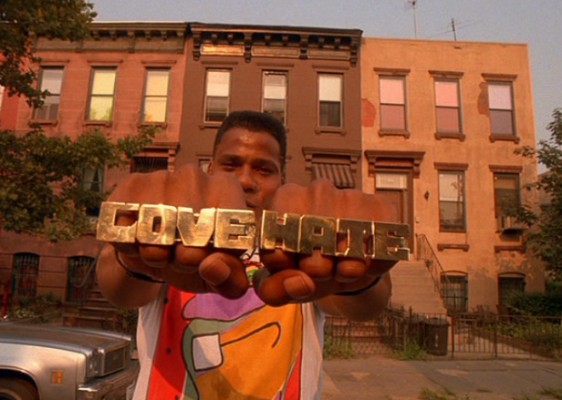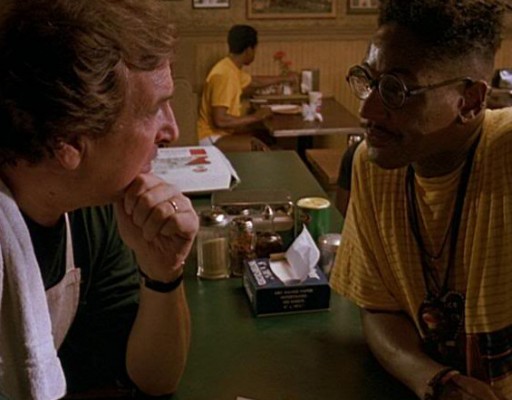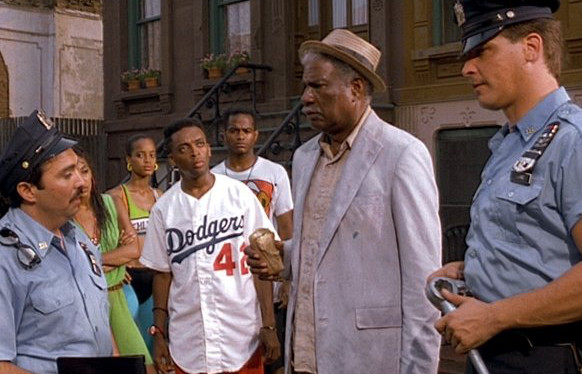National Review
This article is published in collaboration with Reverse Shot. Do the Right Thing is being shown at Museum of the Moving Image on Saturday, July 13, 2013, at 4:45 p.m., as part of the series See it Big: The American Epic.
On paper, Spike Lee’s Do
the Right Thing (1989)—a modestly budgeted comedy-drama
that took place entirely on a single
Brooklyn block on the hottest day of the year—might seem a curious fit for the label
of “American Epic.” Traditionally, when we think of what constitutes “epic”
cinema, we might imagine inflated running times, mega budgets, sweeping vistas,
and the leap-frogging of decades. And, if we’re talking specifically about
Lee’s oeuvre, isn’t Malcolm X (1992), his
201-minute, $33 million, continent-hopping biopic of the life and times of the
eponymous activist and orator, a safer bet for the label in such a
retrospective?
If we cast away
such generic preconceptions, it soon becomes apparent that the earlier film is
the bolder choice. Within the strict temporal and location confines of Do
the Right Thing lies a work concerned with tackling the biggest of American
themes—race relations, ambition, urban survival, economics, violence, and
liberty—on a microcosmic scale. With its thrillingly unorthodox blend of
Aristotelian unity and Brechtian artificiality, it locates the big in the
small, and the national in the local. Over 120 swift minutes, it
assails the viewer with a mixture of character drama, comedy, poetry, music,
and then, in its riot finale precipitated by the cops’ murder of young Radio
Raheem (Bill Nunn), dares to echo SNCC member H. Rap Brown’s darkly diagnostic
pronouncement in the 1960s that "violence is as American as cherry pie."
(He meant “apple,” but he made his point.) Intended by Lee as an artistic
response to the racial tensions in a New York City then under the Mayorship of
Ed Koch, the film sparked huge controversy, prompting a host of misguided
cultural critics to speculate that it would cause riots. It didn’t, of course,
but it struck a nerve because it said more about the state of contemporary race
relations, and with more complexity and brazen confidence, than any other film
in the American cinema to date.

Bill Nunn as Radio Raheem
With so many sensitive,
provocative themes and issues jostling for space in its bloodstream, how does Do
the Right Thing cohere? The answers are myriad, but the most obvious stares
us in the face; viewers seeing the film for the first time on the big screen
will immediately notice its vibrant, unified aesthetic sensibility.
Cinematographer Ernest Dickerson, a key Lee collaborator who shot the
director’s first seven films, was tasked with making the results of an
eight-week, often-rainy shoot look convincingly like one scorching day, and he
succeeded beautifully. With visual nods to the boldly colorful tableaux of key
twentieth-century African-American painters Jacob Lawrence and especially
Romare Bearden, Dickerson crafts a poetically heightened version of a
recognizable urban location (Bedford-Stuyvesant) through expressive use of
space and light. Heat is conveyed through vivid oranges, yellows and
particularly reds; the wall behind the triumvirate of squabbling corner men
(among them the late, great Robin Harris) is one of the reddest reds in all of
cinema, matching William Eggleston’s famous photograph Red Ceiling (1973) for
sensory shock. Ruth E. Carter’s day-glo costumes add to the visual candy,
though they are perhaps the single component which dates the film significantly.

Danny Aiello and Giancarlo Esposito
It takes 20 fairly
laconic minutes for Lee to introduce us to the film’s large, lively ensemble
cast, but its serious political engagement is apparent from the very opening
moments, in which an instrumental rendition of the Negro spiritual “Lift Every
Voice and Sing” (the African-American national anthem) segues into the
juddering clarion call of Public Enemy’s anthem “Fight the Power”—the effect a
polyphonic bridge between old and new forms of protest. As best exemplified by
the recurrent use of the New York rappers’ song, some of the film’s politics
are unambiguous. With the film’s climax inspired by the 1983 killing of NYC
graffiti artist Michael Stewart at the hands of the NYPD, there is no room for
interpretation of the pre–closing credit dedication to the families of seven
African-Americans murdered in preceding years. Neither can we doubt the
genuineness of the call from local DJ Mister Señor Love Daddy (Samuel L.
Jackson) for New Yorkers to get out and vote for mayoral candidate David
Dinkins (who went on to succeed Koch in 1990); Lee was a vociferous supporter.
Elsewhere, however, the director leaves the politics deliberately,
provocatively ambiguous.
Lee is fond of a
dialectical approach to addressing issues, the most obvious (and most critically
chewed-over) example of which is found in the closing use of a pair of quotes
from the two most prominent African-American political figures of the 20th
century, Martin Luther King and Malcolm X, containing their contrasting views
on the use of violence. But this irresolution runs through the rest of the film
like silk. Take agitator Buggin’ Out (Giancarlo Esposito), who could be seen as
an avatar for the aggression and lack of political focus of the late ’60s Black
Power movement (he wears a small Black Power pendant); then again, his
plot-catalyzing fury at the lack of black faces on the wall of Sal’s Famous
Pizzeria, and subsequent wish to boycott the restaurant betray both a keen
awareness of the importance of local cultural agency, and an adherence to
Kingian forms of African-American protest (the Montgomery Bus Boycott, 1955-6).
In short, he wants to hit Sal where it hurts: the pocket. Because the film is
so deeply rooted in character, its Brechtian “epic theater” elements (including
numerous fourth-wall breaks and political slogans placed strategically in the
frame) are never allowed to override the human drama. One of the film’s most
underplayed micro-tragedies concerns Italian-American pizzeria owner Sal (Danny
Aiello), and the absolute disinterest exhibited by his sons in continuing his
family business—a business he built 25 years ago with his bare hands,
presumably the son of immigrants in search of the American dream.

Spike Lee and Ossie Davis
Being an American
epic, Do the Right Thing is necessarily
preoccupied with capitalism—after all, money is the practical cornerstone of
any serious bid for the attainment of that elusive, aforementioned American
dream. To “get paid” is all Mookie (Lee, proving a surprisingly effective de
facto leading man)—pizza delivery guy, feckless boyfriend/father, affable
everyman—wants to do. Counting dollars is the first and last action we see the
character perform. Here, Lee elides the boundaries between star, director and
his public personae. Some sniffy pundits charged him with accusations of
“corporate populism” at the time, the irony being that Lee, an unabashed
capitalist who’d already developed a public brand and made many commercials
with Nike, would never think to receive such slights as criticisms. Consider
the playfully double-edged scene in which Buggin’ Out has his Air Jordans
scuffed (in extreme close-up, no less) by a passing cyclist; it operates as a
simultaneous sending-up of this vainglorious character and no doubt a lucrative spot
of product placement. Lee, unlike, say, the filmmakers associated with the
‘L.A. Rebellion’ movement who made stark, poetic works about the travails of
everyday life in the area’s African-American community (Charles Burnett’s Killer
of Sheep, Billy Woodberry’s Bless Their Little Hearts),
wanted, needed his films to be seen and
discussed by the masses. A true American showman, Lee’s masterstroke with Do
The Right Thing was to deploy all the characteristics associated with an
uncomplicated good time at the cinema—it’s funny, has an attractive cast and a
marketable soundtrack crammed with popular hits—as a Trojan horse for
incendiary political content.
The passage of time
has only seen Do the Right Thing’s status as an
American classic increase. It’s referenced continually in popular culture,
taught in colleges and universities across the country, and frequently appears
on best-of-decade lists. Perhaps the key reason for its reputation lies in its
prescience, a corollary of its honesty in not professing to know the answers to
the urgent questions it raised about contemporary American life. Sadly, as
exemplified by the 2009 killing by police of handcuffed black teenager Oscar
Grant in California (now dramatized in Ryan Coogler’s Fruitvale Station), that
fact that contemporary filmmakers are still having to pore over the unresolved
injustices of Koch-era New York (Ken Burns’s The Central Park Five),
and the current division of a nation over the Trayvon Martin/George Zimmerman
trial, it seems that America’s race relations may not be in a discernibly
healthier state than in 1989, when Lee made his defining artistic statement.
![]()
LATEST ARTICLES
-20140814-173707-thumb3.jpg)
Fighting Words
by Imogen Sara Smith
posted August 12, 2014

Fighting Words, Part 2
by Imogen Sara Smith
posted August 20, 2014

On the Margins: The Fil…
by Andrew Chan
posted August 12, 2014

Robin Williams: A Sense…
by David Schwartz
posted August 12, 2014
 National Review
National Review
RELATED CALENDAR ENTRY
July 13, 2013 Do the Right ThingJuly 5–28, 2013 See It Big! The American Epic
THE AUTHOR
Ashley Clark is a freelance film journalist and programmer based in London. His writing has appeared in Sight & Sound, Little White Lies, Reverse Shot, Slant, The Guardian, and several other publications.
More articles by Ashley Clark
